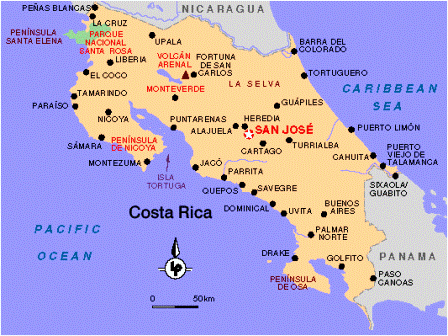Saturday 30 April 2005
Ottawa
Yes, this is the last episode for Central
America 2005. We are back in Ottawa now, safe and sound
and well tanned after a great three months away. We had
three flights coming home, landing in progressively more
northern cities with progressively colder temperatures.
Even in Miami Ray suggested we look into the next flight
heading back to the sun! But Spring is coming to Ottawa.
The snow is gone, tulips are coming up and bikes are on
the streets.
Costa Rica and Panama are renowned for
their Nature Reserves. We managed to visit several of
them and really enjoyed seeing all the wildlife, but my
Spanish didn't get a chance to improve. So many English-speaking
tourists visit these places that everybody in the tourist
industry speaks English. I must admit it made it easier
for us. Monteverde, Costa Rica, was a case in point,
where all the hostel owners, guides and restaurants gave
good service in English.
Monteverde is a National cloud forest
wildlife reserve high in the mountains. The altitude and
frequent rain create a unique microclimate but the trip
there is not easy. We had a long bumpy road in a bus over
roads that would have been condemned anywhere else. It
took us three hours to travel the last 35 Km on narrow
twisting roads, but the scenery on the way was worth it.
We stayed in the town of Santa Elena, a 6 Km ride on a
shuttle bus from two great reserves. The climate was cool
and a pleasant change for the heat of the lowlands. The
restaurants and hostels were good and the hiking and
wildlife were great.
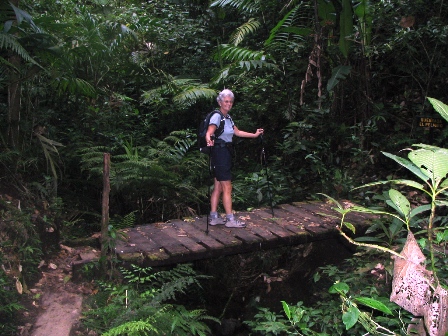 There are all sorts of activities to
chose from in town but everything came with a stiff price
so we limited ourselves to the parks. We passed on the
zip line canopy tour (sob, that was my choice), the
butterfly farm, Serpentarium, Ranario (frog house), and
orchid garden. We hiked over
nearly all the 12 Km of trails in the Reserva Santa
Elena, a less popular reserve with an observation tower
overlooking the forest. We followed a birder group,
waiting patiently to see a Three-Wattled Bellbird, so we
too could view it through their powerful scope. We went
on a guided Night walk in Reserva Monteverde, the
original cloud forest reserve, to see all the creatures
that stir in the night; mostly bats, bugs, tarantulas,
sleeping birds and an Olingo, like a large squirrel with
a prehensile tail. I also
elected to join an excellent guided day tour in Reserva
Monteverde while Ray went on his own walk back to town. I
waited in vain to see a Quetzal bird return to a special
nesting box on the trail, but I did see lots of humming
birds, howler monkeys, white-faced monkeys, and other
colourful tropical birds. Wild impatience, that I like so
much, is considered a pest in Central America but I found
out that the stem juice is a salve for itchy mosquito
bites. There are all sorts of activities to
chose from in town but everything came with a stiff price
so we limited ourselves to the parks. We passed on the
zip line canopy tour (sob, that was my choice), the
butterfly farm, Serpentarium, Ranario (frog house), and
orchid garden. We hiked over
nearly all the 12 Km of trails in the Reserva Santa
Elena, a less popular reserve with an observation tower
overlooking the forest. We followed a birder group,
waiting patiently to see a Three-Wattled Bellbird, so we
too could view it through their powerful scope. We went
on a guided Night walk in Reserva Monteverde, the
original cloud forest reserve, to see all the creatures
that stir in the night; mostly bats, bugs, tarantulas,
sleeping birds and an Olingo, like a large squirrel with
a prehensile tail. I also
elected to join an excellent guided day tour in Reserva
Monteverde while Ray went on his own walk back to town. I
waited in vain to see a Quetzal bird return to a special
nesting box on the trail, but I did see lots of humming
birds, howler monkeys, white-faced monkeys, and other
colourful tropical birds. Wild impatience, that I like so
much, is considered a pest in Central America but I found
out that the stem juice is a salve for itchy mosquito
bites.
We went from the highlands back down to
the steamy coast to visit another nature reserve, Manuel
Antonio. We passed miles of Palm oil plantations on way
to Quepos, the gateway town to the reserve. Quepos is a
fishing center with nice looking but polluted beaches. We
found it hot, not very pretty, but the shops were good. I
bought a new, custom made swimsuit and discovered a good
book exchange store owned by an English girl.
Manuel Antonio Park was 7 Km
away from Quepos up a road lined with pricey resorts. We
arrived one morning at the same time as several large
guided tour groups. It took us a while to get into the
less crowded area, but we were soon on our own staring at
Three-toed Sloths, white-faced monkeys and smaller red
squirrel monkeys in the trees. Agoutis, a large rat
cousin, and iguanas ran through the underbrush. Whenever
one of the guides was stopped with his spotting scope set
up, we would join in to see an animal or a tropical bird.
We walked along the well-marked paths to look down on a
wide expanse of beach, where we later went swimming. No
wonder the park is so popular.
The Lonely Planet Guidebook
described the tiny beach town of Uvita on the Pacific as
what beaches used to be like before Costa Rica was
discovered by tourists. We took a rough bus ride along
the coast to Uvita, passing the aptly named Bumpy Road
Café. A few gringos stopped at the surfer beach of
Dominical, but we continued on to the quieter shores.
Uvita delivered as promised. More than 1 Km of deserted
beach, part of a nature reserve, awaited us. The waves
were gentle enough for a good swim, but big enough at one
end for surfers to practice. We had our first sustained
rain, a sign that the rainy season was beginning. Luckily
it didn't interfere with our beach time.
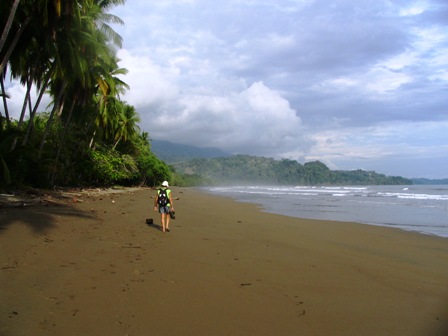
Ray on Uvita Beach |
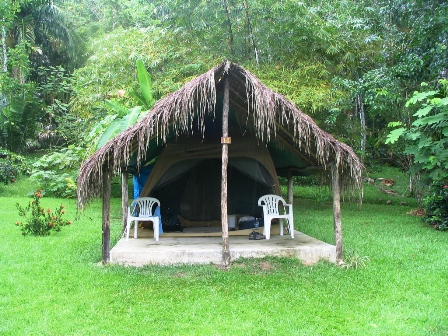
Our tent at Bahia Paraiso Resort |
Our last stop in Costa Rica was to
be a visit to Corcovado National Park on the Peninsula de Osa. My
guide-books promised wildlife and birds galore, so we had to go. The
best way to see the park is the hike for several days, staying in
ranger's stations. It didn't sound enticing given that the rainy season
was beginning and we weren't keen to carry sleeping bags and food. A
tour guide in Uvita suggested we go to Bahia Paraiso Resort, a short
distance from the park entrance. Bahia Paraiso was more expensive than
we usually pay, but we were ready for a bit of pampering. We economized
by opting to stay in a tent set up with comfortable beds, rather than a
more expensive room with bath. We took buses to a small town on the
Pacific where a motor boat took us for an hour and a half ride down a
mangrove river and into the ocea
The small resort was on a half-Km
snorkelling beach, the best one on the coast. The cooks
outdid themselves with three terrific meals every day. If
we had stayed any longer we would have packed on the
pounds. As it was, we made sure we had lots of walks and
swimming to stay in shape. One morning we followed Fredy
on an early morning bird walk through the resort's
botanical gardens. Bushes with fuzzy white and pink
flowers, planted to attract hummingbirds, were full of
Rufous-tailed and Long-tailed Hermit varieties. Fredy
told us that the rather plain looking Clay-coloured Robin
was the nation bird of Costa Rica because its song meant
the rainy season, so important to the farmers, was
beginning. The area was full of birds. At noon each day a
pair of noisy Scarlet Macaws visited an almond tree on
the beach to eat their fill of nuts before decamping to
another tree.
On top of a hill
behind the resort is a mirador overlooking the bay. As we
followed the trail upwards we were suddenly pelted with
sticks and fruit. It was a troop of white-faced Capucin
monkeys, defending their favourite tree. At least they
didn't pee on us, as they have been known to do.
We missed seeing the full effect of a
solar eclipse because of clouds, but the next day the
tides were especially low and high. Low tide was the best
time for snorkelling just off shore because the rocks
where the fish congregate were close to the surface. One
of the staff caught a Guinea Fowl Puffer fish in his
hands and passed it to us to hold. It immediately blew
itself up to look scary and floated on the surface, but
it was really very harmless.
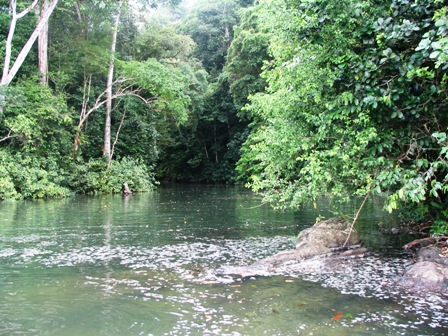
Rio Claro |
A trail along the shore ended
up at the mouth of a river, Rio Claro, where a local man
offered canoe rides into the jungle. He paddled and we
sat back and enjoyed the scenery. He pointed out small
caiman crocodiles sunning on the river bank just an arms
length away. Jesus Christ lizards, so-called because of
their ability to run very fast over water, demonstrated
their skill getting to the safety of the shore. A
kingfisher darted into the water and toucans called to us
from the trees.
Another walk in the other direction along
the coast headed to Corcovado Park. It took us two hours
of pleasant walking along beaches and around rocky points
to get to the ranger's station but we didn't need to go
any further into the park. We had just as much or more
wildlife right at Bahia Paraiso.
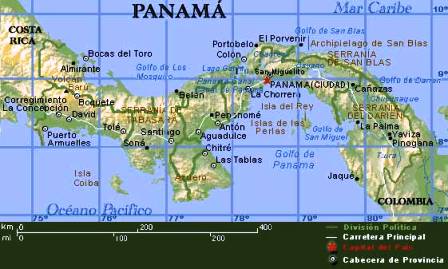
Click
the map above
to see an album of Panama photos. Close the window to return to
this page. |
From Bahia Paraiso we took the boat back
to the mainland and a bus to the Panama border. That
border crossing took the prize for the worst in Central
America. A brand new border station is in the process of
being built but until it does, take advantage of people
who offer their services as border guides. We thought we
knew the routine and refused the services of the first
young man who approached us. We made a mistake. There
were no signs in any language to guide you through the
maze of trucks, buildings and people. We found the Costa
Rica Immigration building and dutifully lined up to get
stamped out, but if we had not accepted the forms we
needed to leave Coast Rica, offered by the first young
guide, there was nowhere else to pick them up. From that
first encounter we wandered around asking directions to
the Panama Immigration. Finally another guide took us in
tow. We followed him across the busy main road, behind
some roadside stands, and past open public toilets to a
small building with a wicket window and a woman sitting
outside behind a table. We paid US$1 to the woman who
pasted a stamp in our passport. From there we followed
our guide across the busy road again, around lines of
parked transport trucks and into another building. Being
Canadians, we were required to buy a $5 Tourist Card.
That sounds easy but not when the only person selling the
cards has gone to lunch. While we patiently waited for
his return at some unknown time, we asked our guide about
converting our small amount of Costa Rican Colones into
American Dollars, which is the currency used in Panama.
That entailed another trip across the traffic back to
where we had purchased our stamp. Our guide located his
money changer friend who gave us a fair rate for our
Colones, then it was back across the road to buy a
tourist card. Finally lunch was over and the Tourist
bureau was manned. We paid our money and the man wrote
our names on a long sheet of paper and handed us a small
hand-written note proving we had paid for a tourist card.
Back we went again to the building where we had purchased
the stamp and handed in our passports and note to a man
in the wicket window. He dutifully stamped our passports
and we were on our way. Our guide showed us to the
correct bus stop and gratefully accepted his tip, which
was well deserved.
Our first destination in Panama was
Boquete, a pleasant town in a craggy mountain valley,
beside the roaring Rio Caldera. We rode through pouring
rain for the first half of the trip but by the time we
reached Boquete, it had stopped and the weather co-operated
for the rest of our stay. We were surprised at the number
of Americans in town. Our favourite breakfast spot each
morning had a group of middle-aged Americans discussing
plans to buy property and build vacation homes. We
wondered what made the area so attractive besides the
nice climate and beautiful scenery. We were told that tax
laws in Panama allow Americans to live there without the
fear of being taxed by both Panama and the US. Add to
that the years that Americans were the custodians of the
Canal and the proliferation of English and it was no
wonder the real estate market was booming.
Boquete is known for its walking trails.
We passed up a long walk to the top of Volcan Baru and
instead walked out of town through numerous coffee
plantations and market gardens. Panama has the highest
per capita income in Central America, but the indigenous
people who live in the hills above Boquete, were in the
have-not category. The Ngöbe-Bugle women wear long
brightly-coloured dresses trimmed with ric-rac and
appliqués, but they live in tumbledown shacks and work
as farm labourers.
The
Quetzal, the Guatemalan national bird, lives in the hills
around Boquete but for us he remained elusive. We took a
taxi out of town for a pleasant walk following a water
pipeline that supplies most of the water for the region.
We saw several pretty waterfalls and heard lots of birds
but the Quetzal remained hidden. We will have to wait for
another trip to see a Quetzal.
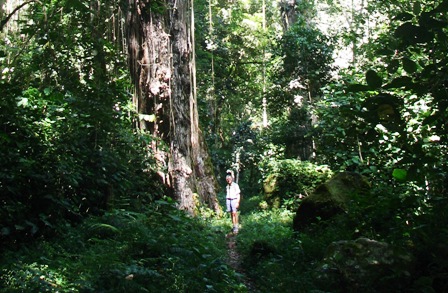
Walk following a water pipeline near
Boquete |
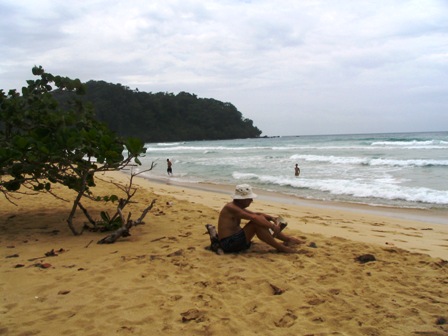
Bocas del Toro, Isla Basimentos,
Wizard beach |
It was time for one last beach experience.
We opted for Bocas del Toro on the Caribbean. The bus
took us up and over the cloud shrouded Talamanca mountain
range, past many indigenous communities. Their homes may
be simple wooden huts on stilts with half walls and a
thatched roof, but the students who boarded the bus on
their way to school were neatly dressed in school
uniforms. Panama boasts 90% enrolment in elementary
school but that drops off to 50% at the secondary level.
The students we saw were the lucky ones.
A 45 minute water
taxi ride from the Caribbean coast took us to Isla Colon,
the largest island in the Archipelago Bocas del Toro (Bull's
Mouth). The main town, Bocas del Toro, is touristy but in
a nice way. Our only problem was the rain. For the first
time the rain interfered with our plans. We did manage a
bus ride to the north end of island to swim on the almost
deserted beach of Bocas del Dragon. We spent a relaxing
morning walking and swimming in the clear waters and had
a great fish lunch at the one restaurant in the area
before it started to rain. It continued all afternoon and
overnight but it stopped in the late morning, in time for
us to take another excursion. We took a short
water taxi ride to the small West-Indian town of
Bastimentos on Isla Bastimentos. After lunch at a
restaurant perched over the water we walked half an hour
over a hill to Wizard Beach on the other side of the
island. Big waves boomed onto a long sandy beach. Surfers
rode the waves while we swam near the shore. We had hoped
to take a last snorkelling trip on a catamaran the next
day but the weather refused to co-operate. It poured rain
nearly all day, leaving us finishing up more books than
we had anticipated. Oh well, it is good to relax in the
tropics.
We left the rain behind and flew to
Panama City the next day, our last stop in Central
America. Panama City was the only capital city we stayed
in Central America and we found it very pleasant. Our
hostal was one of the best with a nice yard, breakfast,
free internet and a big TV.
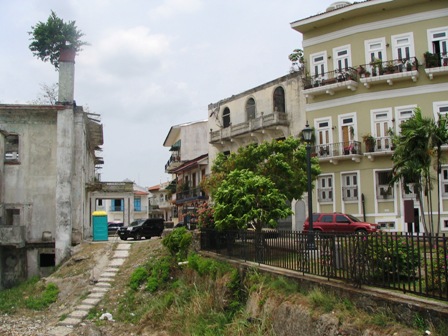
contrast of derelict and renovated
buildings in Casco Antigua |
We took
a bus to visit Casco Antigua, the oldest section of town.
It is not considered safe at night but we found it
charming during the day. The 1989 American Invasion of
Panama after Noriega declared himself President and
announced that Panama was at war with the US, left many
buildings in the Casco Antigua empty shells. Buildings
are gradually being restored but many are still ruins. Noriega's compound
has been left as a ruin next to a pretty esplanada that
runs along the top of a seawall built by the Spanish to
protect the city long ago. At the other end is Plaza de
Francia with monuments to the French who conceived and
started building the Panama Canal. The thousands of
workers who died of Malaria during construction and the Cuban doctor Finlay who
discovered a cure and eradicated malaria from Panama are
also commemorated. We had a good lunch at sidewalk café,
then walked back to find our return bus. Luckily a few
locals realized we were confused by the many buses and
came to our rescue. They brought us to the right bus and
even spoke with the driver to make sure we would get off
at the right stop. We would hope that Canadians would be
as helpful to visitors.
We couldn't visit Panama
without a visit to the Panama Canal. Our last day in
Central America included a visit to the Miraflores locks
for an interesting and informative tour of the canal. We
started on the highest of three observation platforms to
watch huge Panamax (maximum for passage through the canal)
sized ships go through the locks. A running commentary by
a guide told us about the ships we could see as well as
other factoids about the canal. When we tired of watching
ships we saw a 10-minute movie giving a brief history and
current day plans for the canal. We also visited their
well-presented exhibits on three different levels of the
tour building. It was a well-spent morning.
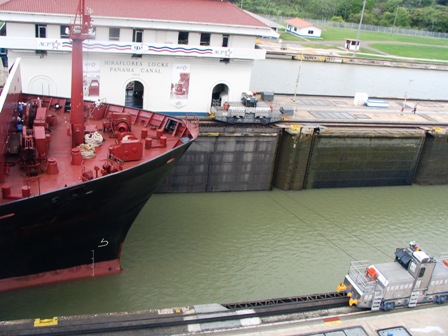
Ship going through Panama Canal |

View of Panama City from Parque
Natural Metropolitano |
Panama City has
several National Parks within easy access of the city. We
took a taxi from the locks to the Parque Natural
Metropolitano on the north end of town to go for a walk.
It reminded me of the Mount Royal Park in Montreal but
larger and tropical. We walked well-marked nature trails
to a viewpoint on top of a hill where we could see all of
Panama City as well as the canal. It made for a pleasant
change from city streets.
Unfortunately that was the end of our
travels in Central America. We left the next day for home.
We have plans to visit Greece and Turkey next autumn but
we haven't decided where we will go after that. There are
too many possibilities to choose from.
|
